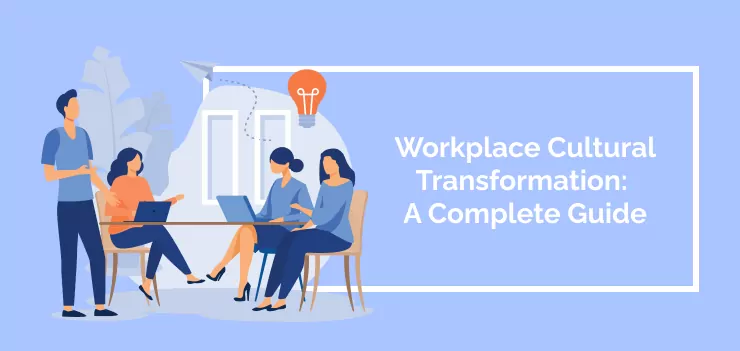
Workplace cultural transformation is the most challenging kind of change management project.
The “human” aspect of any change project is always challenging. Just think of a digital, structural, or merger transformation. In these cases, the changes in technology or structure are difficult enough to achieve. But then, it is even harder to make employees adapt quickly to the changes. With time, training, empathy, and support, staff will adapt to an easier working method.
It’s different with workplace cultural transformation. The complete change process is about human aspects of company culture. Every change is about the “hearts and minds” of staff. The core values of the company may change. It takes a special kind of expertise to support this organizational change.
So that’s why we’ve put together this guide to workplace cultural transformation. We start by defining workplace cultural transformation and showing how important it is for any organization. We’ll then describe three key models for workplace cultural transformation.
These will include a “top-down” model’; a warning about centralized decision-making, and Deloitte’s Agile cultural transformation methods.
This article will give you everything you need to know to plan your next business transformation.
What is Workplace Cultural Transformation?
A workplace culture is the shared values, beliefs, attitudes, and practices that shape how people work in a company. It includes personal job satisfaction, interactions between staff, interactions with customers, and attachment to the organization. It can also be called “organizational culture” or “corporate culture.”
Workplace cultural transformation is a wide-ranging effort to change an organization’s members’ fundamental values, beliefs, attitudes, and behaviors. The specific aims of a cultural transformation project will depend on the company’s current challenges and hope for the future. Common goals include:
- Better Inclusivity and diversity
- Employee satisfaction and wellbeing
- Improving productivity
- Responding to new challenges.
In this section, we’ll explain the meaning of workplace cultural transformation in detail. We’ll look at its relevance to the workplace, some of the problems that a workplace cultural transformation can solve, and explain the difficulty of a workplace cultural transformation.
The relevance of Workplace Culture transformation in 2023
The concept of workplace culture (and its transformation) is relatively new. Business leaders and researchers started writing about this topic in the 1950s. At that time, countries like the US and UK were moving towards a post-industrial economy. Corporations were growing, work environments became more office-based, and workers began to have new workplace expectations.
Many things have changed since that time. But countries with strong knowledge economies and tertiary industries have been forced to value organizational culture like never before. In 2023, well-being, positivity, burnout, and social purpose are important goals for everyone.
Moreover, in this rapidly changing world, a positive culture supports changes of other kinds. Indeed, PWC’s 2021 Global Culture Survey suggested that 72% of leaders felt that culture was vital for preparing for further changes.
Organizational culture is one of the hardest things to change. But companies benefit from cultural change projects for many specific problems.
When do you need workplace cultural transformation?
Workplace cultural transformation can solve problems that seem to be otherwise impossible.
Workplace cultural transformation can solve big business problems like mergers, emerging opportunities, and new company objectives. Other issues that need to start with a cultural change include institutionalized discrimination, sustainability activities, and other issues in social responsibility.
Individual business units may face smaller problems that cultural transformation can solve. Those may include
- Too much emphasis on short-term goals
- Excessive internal competition.
- Distance between rank-and-file and leaders
- Routine project over-spend
- Poor time management, scheduling, and deadline-breaking
- Perceived (or actual) favoritism of one department over another.
These challenges are relatively small. But they can impact the success of the whole company.
Why is workplace cultural transformation difficult?
Cultural transformation is known as one of the hardest types of change projects. Why is this so?
We must remember that workplace culture exists at many different levels.
Some aspects of workplace culture are visible to everyone. An organization’s leaders might talk about its values in detail. Perhaps those values drive the performance management procedures.
But underneath, there is a massive range of assumptions that people live by. Even insiders will struggle to explain these values.
The visual culture might be easy to change. However, the invisible aspects of culture could be very difficult to change!
As a result, cultural transformation is an art, not a science. Leaders need exceptional persuasive talents, carefully-honed success narratives, and genuine empathy with their staff to prove that the new way is better. Facts and figures are not enough!
Three Ways that Cultural Transformation is Important
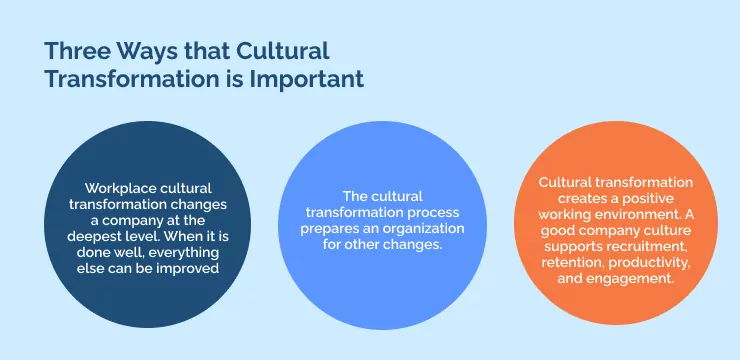
Workplace cultural change makes a big difference.
Does that mean a cultural transformation is right for everyone? Not. In this section, we’ll take a moment to explain why cultural transformation is important. In brief, the reasons are:
- Workplace cultural transformation changes a company at the deepest level. When it is done well, everything else can be improved.
- The cultural transformation process prepares an organization for other changes.
- Cultural transformation creates a positive working environment. A good company culture supports recruitment, retention, productivity, and engagement.
If you need results like these – maybe workplace cultural transformation is a worthwhile investment.
Workplace Cultural Transformation goes Deeper
When a company faces deep challenges to its stability, they have many choices about what to do. In different circumstances, leaders may decide on any of the following options to help pick up for the future:
- Digital transformation
- Business process optimization
- Structural transformation
- Market positioning
- Downsizing
These change projects often lead to better results. But if there is a toxic culture in a staff of 500 people, the culture will still be toxic when there are just 250 employees. And if people don’t trust their leaders, a fancy new ERP suite won’t change that!
So when changes have to go deeper, it will be necessary to do cultural work to the core of what the company does.
Workplace Cultural Transformation Prepares for other changes
A strong workplace culture is fundamental for any type of organizational change.
As a 2021 Sloan Review article explained, “Companies cannot realize the true potential of digital transformation, embrace new business models, or implement new ways of working without supporting changes in organizational behaviors and norms.”
Even technical implementation depends on strong company culture. If you plan to introduce a new piece of software, for example, it will only succeed if staff are willing to adapt and change to the new way of doing things.
If a company already has a culture of trust and agility, its staff will be ready to do what it takes to improve performance.
Creates a stable and attractive work environment
Staff engagement and job satisfaction are complex areas of management. But company culture can quickly improve retention, recruitment, and satisfaction.
A 2022 survey by the Society of Human Resource Management showed that
- in companies where the culture is “poor,” 90% of people had thought of quitting.
- In companies where the culture is “average,” 72% had thought of leaving.
Upgrading from an “average” culture to a “positive” culture reduces these problems dramatically.
The Benefits and Pitfalls of Workplace Cultural Transformation
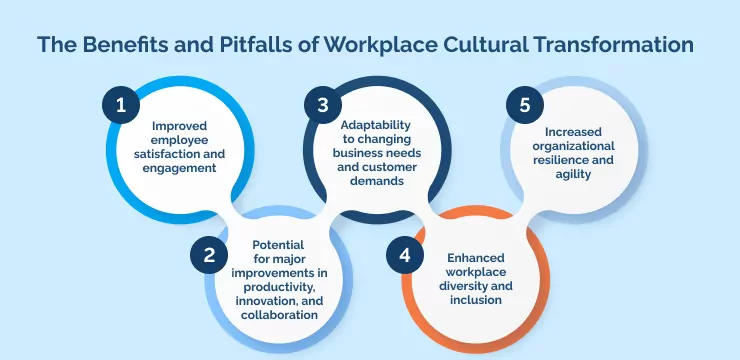
Transforming workplace culture is a complex process that requires time, effort, and a deep understanding of the organization’s culture. It’s a journey that may come with both benefits and pitfalls. In the next section, we’ll look at three different workplace cultural transformation models. Before we do, let’s just remember some pros and cons of workplace cultural transformation.
Benefits:
- Improved employee satisfaction and engagement
- Potential for major improvements in productivity, innovation, and collaboration
- Adaptability to changing business needs and customer demands
- Enhanced workplace diversity and inclusion
- Increased organizational resilience and agility
Pitfalls:
- High possibility of failure
- The challenge of aligning local goals with an organization’s bigger picture
- The difficulty of understanding the existing workplace culture,
- Workplace culture is constantly evolving, making it difficult to identify and address problem-causing behaviors
- There’s no one-size-fits-all solution. Every organization has its unique challenges and requires a tailored approach
By recognizing the potential benefits and pitfalls of workplace cultural transformation, organizations can better prepare for the journey ahead and make informed decisions that will facilitate a successful transformation
Three Models of Workplace Cultural Transformation
There is no “one size fits all” approach to workplace cultural transformation. This is a complex area of expertise. The most relevant case studies, models, and theories will differ for every company.
So, we will now share three key models for producing major cultural transformation. With the help of Kotter and Heskett, we will think about the role of a charismatic leader in creating change. We’ll question the part of centralized decision-making and show how Deloitte suggests an agile model for cultural change.
Kotter and Heskett’s Top-down Model

Let’s start by taking a step back in time. In Kotter and Heskett’s classic book from 1992, Corporate Culture and Performance, they argued that leadership was the most important part of managing cultural change. Because cultural change is so hard, it’s really important for someone with great power to lead the company.
They found some specific activities in good change leaders.
- The leaders who created effective cultural change came from outside the company. So, these leaders had already proved their leadership skills. They were able to bring new perspectives on old problems. And they came with brilliant persuasive skills, which helped them create consensus among their closest colleagues.
- When the leaders arrived in their company, they quickly took control of the change. In some cases, they even created a sense of crisis about the changes they had to make. This meant that everyone understood that the company needed urgent change.
- In this context, the leaders challenged the status quo. They did so through extensive communication with employees, to a far greater extent than their predecessors. In these communications, the leader’s vision was vital to motivating.
- Many staff changes backed up their communication. Leadership staff needed to leave the company, with bold new hires taking their places. In some cases, the changes in hiring practices were even deeper. Leaders reviewed selection criteria and hiring processes, helping the team quickly bring the right staff on board.
Sometimes, we might see cultural change through rose-tinted glasses. After all, leaders just want to make everyone happy, right?
But Kotter and Heskett remind us of reality. Workplace cultural change won’t always be a dynamic joy-filled experience. It will involve some challenging moments. And companies may benefit from a visionary leader. They can keep the company moving forward at the most difficult times.
In 2023, we know that effective change rarely trickles down from the top of an organization to the bottom. But Heskett and Kotter’s study reminds us of some important lessons: effective leadership, an outside perspective, and extensive communication are vital for change management results.
Centralized Decision-making: A Warning
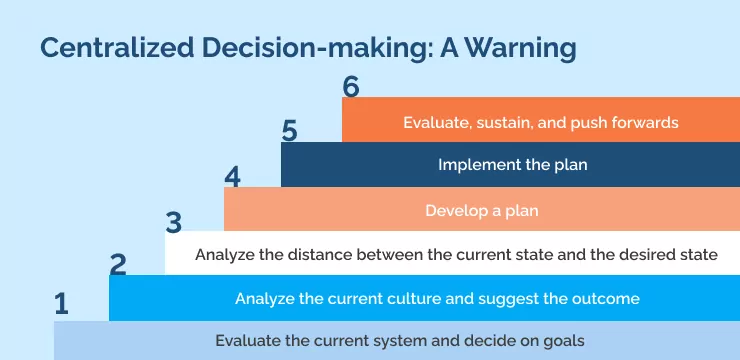
When you search for models of cultural change, you’ll most likely find many “n-step models.” They will give you a certain number of steps to take – maybe 5, 7, 10, or 22 steps. After that – bingo! Your corporate cultural change is complete!
But is this a realistic method?
In their 2015 book, Changing Organizational Culture, Alvesson and Svengisson discuss this approach. When people suggest “N steps” in the cultural change process, they usually use this process:
- Step 1: Evaluate the current system and decide on goals.
- Step 2: Analyze the current culture and suggest the outcome
- Step 3: Analyze the distance between the current state and the desired state
- Step 4: Develop a plan
- Step 5: Implement the plan
- Step 6: evaluate, sustain, and push forwards
(Alvesson and Svengisson found that there is some variation in the steps. But the basic pattern is the same.) In each step of the plan, advisors suggest you use a range of familiar tactics. They include new recruitment practices, extensive communication, training programs, and performance management.
So far, this approach sounds quite sensible. Right?
Alvesson and Svengisson are not so sure. From their detailed studies of change management, they point out that:
- Corporate culture is fragmented. That means the culture is different in different business units, at various management levels, and between different generations of hires. At one moment, it’s difficult to understand what “company culture” is.
- When you implement new cultural changes, the response to change is also fragmented. Staff will behave unpredictably: this is just human nature! Furthermore, an “N step” process does not consider unpredictable ways that the team will respond.
- So, if you want a successful cultural transformation, you must accept these challenges. Most importantly, you should be careful about centralized decision-making. In many organizations, a centralized change process will fail.
Can you achieve cultural change through “N steps”? Maybe. If you are the leader of a small company, with close connections to your staff, perhaps it will work ok. However, for an alternative model, let’s get into our next example. Deloitte’s model shows us how to create a cultural transformation process that is more sensitive to human complexity.
Deloitte and the “activation” of culture
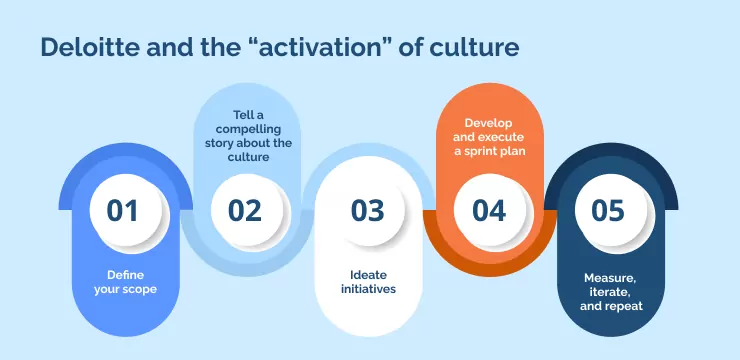
Deloitte offers an adaptable, flexible, and sensitive approach to cultural change. Deloitte’s guidelines for workplace cultural change do not advise on visionary leadership. And it does not expect staff to change immediately. Instead, they show how small changes can lead to the overall change in direction that the organization needs.
Deloitte starts with the concept of activating behaviors in the company’s people. In their view, behaviors become habits, and habits make up the overall culture. In this model, you must make strategic choices about the most important activities to change: which behaviors and attitudes align best with the outcomes that they want?
They then advise on five elements of the change process.
Define your scope. Identifying the vision of change; the community of people it will impact; the levers of change; and the core behaviors.
Tell a compelling story about the culture. The story must show how the desired behaviors will positively impact your organization. A culture story is not just about sales figures and bar charts. It should be engaging, reassuring, and inspire employees.
Ideate initiatives that will lead to widespread behavioral change. At the very least, use a combination of workshops, coaching, and strong communication. These are necessary tools for influencing culture positively.
Develop and execute a sprint plan focusing on a small-scale project lasting 4 to 8 weeks. Deliver specific outcomes and learn lessons that you can apply in future sprints.
Measure, iterate, and repeat. Remember, the first sprint won’t complete the culture change. Instead, it’s an opportunity to test and evaluate your approach. Ensure you engage your staff in the process and use their feedback to refine your strategy.
Deloitte’s approach offers a great solution for a gentle and responsive change project.
Workplace Cultural Transformation: The Next Steps
The three models we discussed are just a starting point for exploring this topic. You might find that one of them suits your organization perfectly. It’s more likely that each one gives you one key insight. An experienced change practitioner can create a solution that fits your needs perfectly.
As we saw early in the article, cultural change management can bring the greatest benefits while suffering the greatest risk. So Before we finish, let’s take a moment to think about one key element – reporting.
As you progress through a change process, remember that cultural change should have clear results. -You can monitor these with surveys, questionnaires, and focus groups and with more technical solutions, such as a digital adoption platform (DAP).
A DAP gathers vital information about staff and technology. When it comes to software, are your staff asking for help? Do they understand that there’s a new solution available?
Such questions are practical. But positive results show that your culture keeps staff moving forwards.
WalkMe Team
WalkMe spearheaded the Digital Adoption Platform (DAP) for associations to use the maximum capacity of their advanced resources. Utilizing man-made consciousness, AI, and context-oriented direction, WalkMe adds a powerful UI layer to raise the computerized proficiency, everything being equal.



